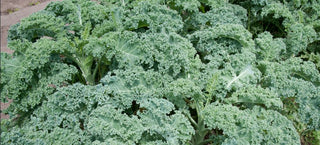
Kale and collards are similar plants, both grown for their flavorful and nutritious greens. The primary difference between them is that collards tolerate heat, while kale prefers cool temperatures. Gardeners in the South will have greater success growing collards rather than kale.
Growing Kale
Kale has all the good nutritional qualities of its close relative, broccoli, but each plant produces a lot more food. This is because we eat the kale plant's leaves, not its flowers (as we do with broccoli). Kale plants are vigorous and not the least bit fussy.
Kale grows well in cool soil and doesn't mind cold weather. Many people feel the flavor gets even better in early winter after the leaves have gone through several hard frosts. Kale is a moderate feeder and needs no more than compost and a little organic fertilizer.
Kale can be started by seed in the garden six weeks before the last frost. The seeds will germinate even in soil that is only 45 degrees F. You can also start a few seeds indoors to get a jump on the season. It takes about three months to get full-sized plants. However, kale can also be grown as a microgreen (harvested 12-20 days after sowing) or baby green (harvested 20-30 days after sowing). Both make beautiful and delicious additions to salads and stir-fries. Gardeners in the south should plant in late summer or fall for a winter crop.
Kale prefers soil that is moist and cool. You can provide these ideal conditions by mulching around your plants with shredded leaves, newspapers or straw. Water during dry spells.
You can start harvesting in late summer by cutting off a few of the bottom leaves with a knife and gradually working your way up the stem. If you don't do this, the lower leaves eventually get tough. When preparing mature leaves for cooking, it's best to slice out and discard the thick midrib.
Kale freezes well. Plunge leaves into boiling water for a minute or so, then cool quickly under boiling water or in a pan of ice water. Drain, pat the leaves dry and freeze them in plastic freezer bags. It's OK to for the leaves to be frozen whole as they're easy to chop while frozen.
Growing Collards
Also in the Brassica (helloooo again, broccoli and cabbage!) family, collards prefer warm soils for germination, although the plants are frost tolerant. For a spring crop, start seeds indoors 6-8 weeks prior to planting outside. For a fall crop, seeds can be directly sown, as the soil is already warm. Plant seeds in moist soils 1/4 - 1/2 inch deep, and be sure to water regularly. Collards will become limp and wilt with insufficient water; water deeply to encourage root growth and mulch around the individual plants if necessary. Moisture-stressed plants will produce tough, bitter leaves.
Collards prefer fertile, well-drained soil. Work compost or a high-nitrogen organic fertilizer into the soil prior to transplanting.
Collards can be harvested 60-80 days after direct seeding, depending on the cultivar. Cut the entire plant, or, to prolong the crop, harvest individual leaves from the bottom up. Microgreens are ready just 10-15 days after seeding.
To protect kale and collard seedlings from cabbageworms and cabbage loopers, cover the plants with row cover (garden fabric) as a barrier to the egg-laying adult moths.





